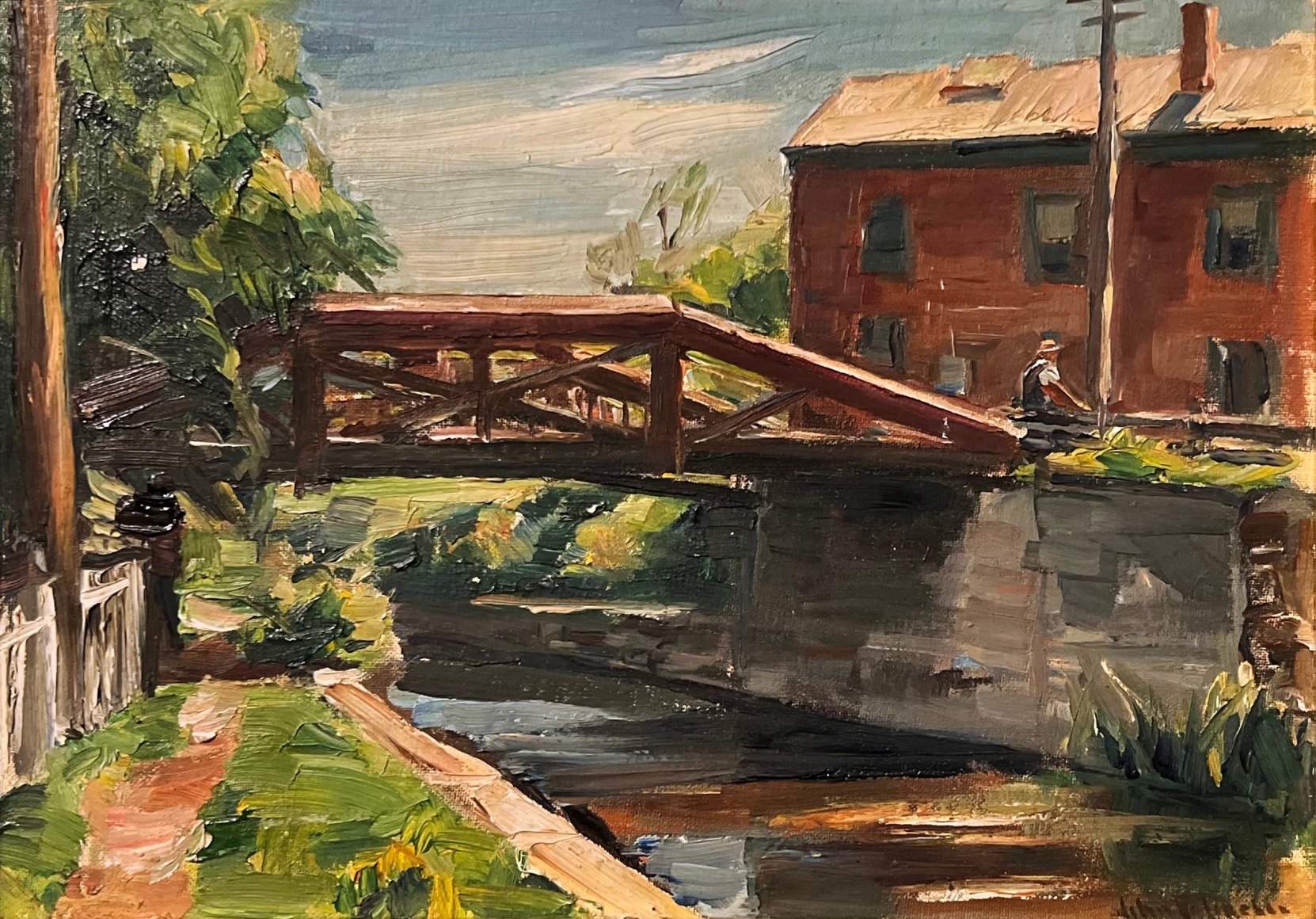John Folinsbee
Biography
John Folinsbee (1892-1972)
The following information, was submitted by Kirsten M. Jensen, PhD, Director of the John F. Folinsbee Catalogue Raisonne. The text below is Jensen's submission to Wikipedia.
John Fulton Folinsbee (March 14, 1892-May 10, 1972) was an American landscape painter and member of the art colony at New Hope, Pennsylvania. He is best known today for his impressionist scenes of New Hope and Lambertville, New Jersey, particularly the factories, quarries, and canals along the Delaware River.
Folinsbee was born in 1892 in Buffalo, New York. As a child, he attended classes at the Art Students' League of Buffalo, but received his first formal training in with the landscape painter Jonas Lie when he was fifteen. Between 1907 and 1911, he attended the Gunnery School in Washington, Connecticut, where he studied with Elizabeth Kempton and Herbert Faulkner. He later studied with Birge Harrison and John Carlson in Woodstock (summers, 1912-1914), and also with Frank Vincent DuMond at the Art Students' League in New York.
At Woodstock, he met Harry (Tony) Leith-Ross, who became a life-long friend and later followed him to New Hope. In 1914, Folinsbee married Ruth Baldwin, the daughter of William H. Baldwin, Jr. and Ruth Standish Baldwin (co-founder of the National Urban League), whom he had met in Washington, Connecticut. They moved to New Hope in 1916, and had two daughters, Beth and Joan.[1]
Early in his career, Folinsbee painted in a tonalist style, with an interest in light and atmosphere that grew directly from his time with Harrison and Carlson in Woodstock. By the late nineteen-teens, he had moved away from tonalism into a more structured, impressionist style. In the mid-1920s, Folinsbee began studying the work of Cézanne, which led to a trip to France in the summer of 1926. The paintings that resulted from this trip, and those that followed later in the decade, reflect a deep understanding of Cézanne's compositional strategies and a desire to reveal the underlying structure of forms.
Folinsbee's exploration of structure led eventually to an analytical, highly individual expressionist style in which he painted for the remainder of his career. His palette darkened, his brushstrokes loosened further, and his sense of light and atmosphere became more dramatic. These later works are concerned with conveying a sense of mood and an intense emotional response to the world around him.[2]
Folinsbee always had a sketchbook or a box of 8 x 10 inch canvasboards with him, ready to capture any scene that caught his eye. He and Leith-Ross were famous for spending afternoons on the bridge at New Hope sketching and tossing anything that displeased them into the Delaware River. Although he painted en plein air, directly from nature, Folinsbee would later transform his small-scale sketches into larger paintings in his studio, and frequently made a number of copies of the same scene on different sizes of canvas.
He was represented by Ferargil Gallery for most of his career, and his paintings were exhibited across the country and in several international exhibitions. Folinsbee won nearly every award given by the National Academy of Design (where he became a full academician in 1929), receiving several of them many times. He also won awards from the Pennsylvania Academy of the Fine Arts, the Connecticut Academy of Fine Arts, the Rhode Island School of Design, the Corcoran Gallery, and the Salmagundi Club, and received a bronze medal at the Sesquicentennial Exposition in Philadelphia in 1926. His work is included in major museums, including the Smithsonian American Art Museum and the Corcoran Gallery in Washington, DC, the National Academy of Design, and the Pennsylvania Academy of the Fine Arts.[3]
Folinsbee was also a teacher, and one of his better-known students, Peter G. Cook (who married his daughter Joan), became a colleague and friend. The two collaborated on three post-office murals in Pennsylvania and Kentucky for the Section of Painting and Sculpture during the 1930s and 1940s. Folinsbee stopped painting in 1971. He died one year later in New Hope.
Notes
1. Peter G. Cook, John Folinsbee (New York: Kubaba Books, 1994).
2. Kirsten M. Jensen, Contour, Bones and Skin: Cezanne's Influence on John Folinsbee." Fine Art Connoisseur 4, no. 4 (July/August 2007): 51-55.
3. http://www.folinsbee.org/honors
Further reading
Cook, Peter G. John Folinsbee. New York: Kubaba Books, 1994. ISBN 0-9639104-1-8
Culver, Michael. "The Art of John Folinsbee." American Art Review 13, no. 4 (August 2001): 106-111.
Peterson, Brian H. (Editor) (2002). Pennsylvania Impressionism. Philadelphia: James A. Michener Art Museum and University of Pennsylvania Press. ISBN 0-8122-3700-5.
Folk, Thomas C. The Pennsylvania Impressionists. Cranbury, NJ: Associated University Presses, 1997.
Hunter, Sam. American Impressionism: The New Hope Circle. Exh. cat. Fort Lauderdale: The Fort Lauderdale Museum of Art and Richard Stuart Gallery, 1985.
Jensen, Kirsten M. "Contour, Bones, and Skin: Cezanne's Influence on John Folinsbee." Fine Art Connoisseur 4, no. 4 (July/August 2007): 51-55.
Online Source
Wikipedia,
http://en.wikipedia.org/wiki/John_Fulton_Folinsbee
Source:
https://www.askart.com/artist/John_Fulton_Folinsbee/24181/John_Fulton_Folinsbee.aspx
